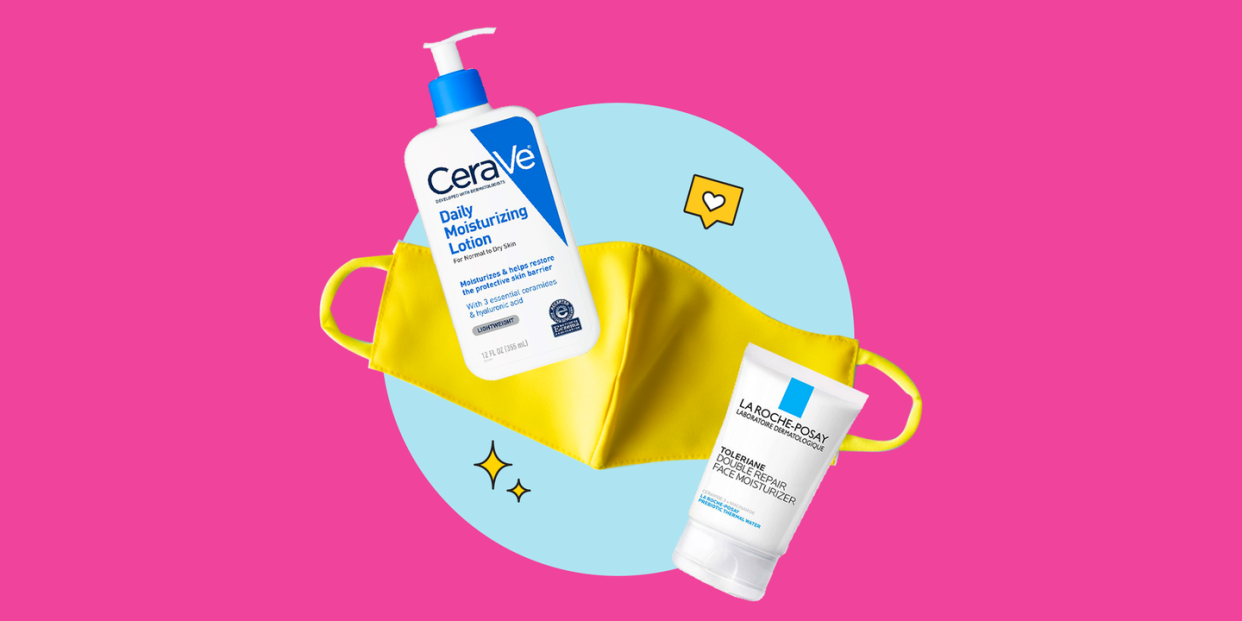Breaking Out From Your Cloth Mask? Here’s How I Cured My Zits

Let me start by saying I realize this is a VERY small (like, so, so small) problem considering the current global crisis, but as a skin-obsessed beauty editor, I need to say it: I’m pretty sure my cloth face mask is giving me acne, because I literally cannot stop breaking out on the lower half of my face.
I mean, sure, it’s possible these clogged pores and little red bumps could be related to stress or my newfound baking habit (hi, sugar) or, IDK, a million other things, but ever since I’ve started wearing a cloth mask while going to the grocery store, running around the block, and just existing anywhere outside my home, breakouts have suddenly and annoyingly taken over my skin.
So I chatted with dermatologist Joshua Zeichner, MD, director of cosmetic and clinical research in dermatology at Mount Sinai Hospital in NYC, to see what was going on, and it turns out my hunch was right: Cloth masks can cause acne, and the breakouts are becoming so common that they now have a clever little name—maskne.
“Face coverings create a humid environment that traps sweat, oil, and bacteria on the skin,” explains Dr. Zeichner, “and they’re likely what’s causing acne in the form of whiteheads, red bumps, and pustules in the areas of skin covered by the mask.” Lol, cool. And since going mask-free isn’t a safe option at the moment (ICYMI, CDC guidelines recommend people wear cloth masks or face coverings in public places), I asked Dr. Zeichner for the best ways to prevent and treat mask breakouts. And thankfully, both are very possible.
1. Get a cloth mask made with breathable fabric—and wash it regularly
If you’re acne-prone, avoid cloth masks made of rough fabrics and opt for ones made with cotton fibers instead. “Not only is cotton softer and less irritating on your skin, but it’s also breathable, which means it’ll create less of a humid environment for breakouts to thrive,” says. Dr. Zeichner.
Also very important: If you’re wearing a reusable mask, make sure you wash that shit. A germy mask is doing your skin (and your health, obviously) zero favors. “Wash your mask after every use with a gentle detergent that’s dye-free and fragrance-free,” says Dr. Zeichner. Dyes and fragrance can get lodged into the mask’s fabric and cause irritation and acne when pressed against your skin for extended periods of time.
2. Keep your face clean
One of the best ways to prevent maskne, according to Dr. Zeichner, is to wash your face with a salicylic acid-infused cleanser. “Salicylic acid is a beta hydroxy acid that effectively dissolves the excess oil, dirt, and dead skin cells that build up in pores and cause breakouts,” he says. Let the cleanser sit on your face for a full 30 seconds so the salicylic acid has a chance to work its clarifying magic on your face.
If your skin is especially oily by nature, you can even wash your face before and after wearing your mask. Sounds extra, I know, but if you’re working up a sweat while wearing a mask (like if you’re going for a jog on a humid day), your skin could benefit from a double cleanse.
And don’t forget to apply an oil-free moisturizer with barrier-strengthening ingredients like ceramides (you can’t go wrong with CeraVe Daily Moisturizing Lotion or La Roche-Posay Toleriane Double Face Repair) after you wash. Without it, your skin can dry out and produce even more oil to overcompensate for the lack of moisture. And, thus, more breakouts.
3. Skip the face makeup
Sry, but wearing foundation—or any sort of face makeup, for that matter—under your cloth mask is a hard no if you want to avoid breakouts. “When makeup gets trapped against your skin in a moist, humid environment, it’s basically a one-way ticket to breakouts and clogged pores,” says Dr. Zeichner. It’s also difficult to fully wash off makeup that gets trapped in your cloth mask, which means you’re potentially just reintroducing more bacteria to your skin each time you rewear it.
And listen, while I’m still fully embracing my no-makeup quarantine face, I get that makeup is a mood booster for some people, so if you still want to wear foundation, pls just use one that’s oil-free and noncomedogenic (like Clinique Beyond Perfecting Foundation + Concealer or Ilia Super Serum Skin Tint SPF 40)—they’re less likely to make you break out when worn under your mask.
Skin is unpredictable. You can do all the right things (aka all the stuff I mentioned above) and still get breakouts. It happens and it’s unfair, but that’s where benzoyl peroxide comes in. “Benzoyl peroxide reduces inflammation, kills acne-causing bacteria, and helps open up pores, targeting all the main causes of red, angry pimples caused by your mask,” says Dr. Zeichner.
But before you go slathering your face with the first benzoyl peroxide product you can find, know this: Benzoyl peroxide is effective, but it can be irritating if you overdo it. As a rule, use it in the lowest concentration available, which is 2.5 percent. “Benzoyl peroxide in lower concentrations is proven to be as effective as in higher concentrations but with less irritating side effects, like redness and flaking,” says Dr. Zeichner.
Personal update: I’ve been following all of Dr. Zeichner’s advice for a week or so now (e.g., using breathable cloth masks, washing them regularly, using a salicylic acid cleanser, and avoiding face makeup), and I haven’t gotten any new breakouts since. My skin’s not perfect (I’m a real-life human with pores…who is still stressed as fuck and loves to bake), but at least I feel better about the whole situation. Consider it one small, small problem solved.
You Might Also Like

